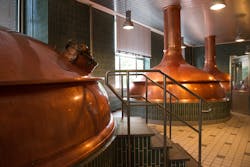The world has changed while you were otherwise occupied. Billions of people the globe over today routinely drink the same beverages and eat the same foods as everyone else. Ten-to-one, it wasn’t like this the day you were born, because the change has come in recent years.
It’s a global-scale evolution in human eating habits made possible by computerization and IT-based process automation.
What then, do leaders at the very largest IT-based automation provider’s process division have to say about the global food & beverage industry?
Despite the fact that global brands must deliver quality-guaranteed product everywhere, "each production plant still tends to have its own recipe management and automation systems. In the future, plants will have distributed systems equipped with standardized automation and centralized recipe and production management," says Eckhard Eberle, CEO, Siemens Process Automation, at a recent meeting held at the division’s headquarters near Nuremberg, Germany.
Global brands must deliver quality-guaranteed products everywhere, yet each production plant tends to have its own recipe management and automation systems. (Courtesy Siemens)
Food and beverage production typically involves a primary batch or flow process, followed by a discrete, packaging process. Production execution and scheduling calls for software applications intermediate between enterprise-business planning and process-control automation. One generic acronym for these type systems is SCADA, for supervisory control and data acquisition.
Another food and beverage differentiator is that, "product design is very different — tastes, recipes based on disparate ingredients, and demand must be factored. In a chemical plant, the process is almost invariably well-defined beforehand. In the food and beverage industry, the scenario is more often that a brand needs capacity, and collaboration takes place over time to define specifics," says Gunther Walden, head of F&B process automation, Siemens Process Automation.
Early indicators
In the not-so-distant past, food and beverage was behind other industries, such as chemical and pharmaceutical, in embracing IT-automation. Spending on IT-based automation in the food and beverage industry is rising based on a change in opinion as to what constitutes return on investment.
While labor salaries remain low in some developing regions, "investment in developing countries is being made with greater emphasis on consistent quality to protect the value of global brands," says Walden.
The end-game for the industry is that any given unit of food or beverage production is defined and modelled such that quality can be managed across global regions using a common data model, model-based simulation and integrated engineering tools supported by cloud services and analytics.
Admittedly, the industry has a way to go before these kind of "apples-to-apples" comparisons become routine.
Nevertheless, pressure for greater quality insight is acute, says Walden, because food and beverage corporations attain global sway by acquiring regional and local entities. "The bigger companies especially will move quickly to end this fragmentation to achieve standardization," says Walden.
Standardization, in turn, allows specialization, as the following example illustrates.
Beer-blast brewing
Besides hops, malt, yeast and water, production data is becoming an ever-more important fifth ingredient for modern breweries. Data used in conjunction with automation determines optimum sequences and efficient production. (Courtesy Siemens)
The global beer business is in a funny place. The world’s two largest brewers, Belgium-based Anheuser Busch In-Bev and London-based SABMiller have been seeking, and struggling, to combine to form a $250 billion group.
At the same time, more than 3,500 craft breweries in the U.S. supply 10 percent of U.S. beer sales by volume, 20 percent by value. And craft brew is spreading to other parts of the world.
At a recent gathering at the Ludwigsburg, Germany, headquarters of brewery equipment and systems supplier Ziemann International, just outside Munich, the current state of the global beer industry is a perceived opportunity. The company has made kettles and tanks for more than 150 years. One-half the brewery tanks it fabricated in 2014 were sold to U.S. craft breweries.
We often hear of giant companies "niched" by smaller, more nimble competitors. Yet for many years in the beer business, the big just kept on getting bigger. But what’s happening with beer today is more nuanced, more global, if you will, than simply a matter of big versus small, and that’s not surprising. After all, for many, many millions of people, beer is as much a magic elixir as it is mere beverage.
Over time, each extreme of the beer market is taking on the characteristics of its opposite.
"When craft brewery growth slows, those brewers will need to automate — to attain scale, stay competitive and guarantee quality. As important, the largest brewers must become more flexible to offer more flavors. That too calls for automation," says Klaus Erich, CEO, Ziemann International.
Already the largest craft brewers produce as much as 700 million liters of beer per year, even as the biggest players acquire craft brewers at an increasingly rapid pace. On the other hand, many small-scale brewers remain adamant in their aversion to automation because it is perceived as diminishing the craft brewer’s hand in a beloved blend.
Control your beer
When a small brewer begins automating its processes, initial technologies involved will include:
- Field devices to automate valve, motor and pump operation;
- Temperature, pressure, level and flow measuring instruments; and
- SCADA software, specific to breweries.
In the 1970s, Ziemann and Siemens jointly developed a control system for the brewing industry, the "Braumat" process control system. The first version of the software was used at the Polar brewery in Venezuela in 1978, and it has been under continuous development ever since. The latest version, Braumat V7, appeared in 2014.
Besides Siemens Simatic 7 controls, Braumat today runs on industrial PCs with the latest Windows operating systems. Production data can be archived on a Microsoft SQL server. It is also equipped with interfaces to Simatic IT MES and supports operator-station virtualization.
MES is an acronym for "manufacturing execution systems," software responsible for short-term scheduling and production-operations management in industrial plants in many different industries. It is thought of as residing just "above" the SCADA system.
Besides hops, malt, yeast and water, "production data is becoming an ever-more important fifth ingredient for modern breweries," says Walden. "The data, used in conjunction with automation, helps determine optimum operational sequences and more efficient production control."
Where complex operational sequences are involved, data availability equates to transparency. If current machine-component information is compared with historical data, maintenance and services can be rationalized.
A comparison of optimized model status with actual day-to-day production highlights production anomalies and can lead to opportunities for energy and materials conservation.
"Simulation allows recognition of optimum process flows and more efficient control of complex sequences," says Walden. "Data can define the process, determine optimum settings for ancillary processes and devices, monitor pipelines, and integrate new technologies."
Simulation at Paulaner
The Paulaner Brewery of Munich, Germany, is building a new brewery in Langwied, on Munich’s outskirts. To facilitate its construction, iSILOG, a simulation service provider, constructed a beverage-industry plant model using the Tecnomatix portfolio from Siemens PLM Software. It includes brewery-specific objects, such as a brew house, fermentation tanks, filters, bright beer tanks, filling lines and storage.
Simulation is used to implement fully validated processes. Under production, alternate planning scenarios can be compared to select the best balance between performance, flexibility and cost.
Input to the simulation model is defined in a spreadsheet program, which includes inputs for customer demand and properties associated with process steps, e.g., brewery, fermentation or warehouse. Tank capacities, filling-line availability and shift calendar for several process steps can be defined.
The solution includes facility-appropriate key-performance indicators. Paulaner can evaluate the influence of stochastic process behavior, such as consumer demand change or machine-maintenance challenges.
In complex systems with large interdependencies, says Siemens, such as in beer production plants, manually estimating how a system will perform is nearly impossible. The use of simulation makes the effective management of such interdependencies a reality.
Final words
Beer production in recent years has enjoyed sustained, uninterrupted growth. According to the Barth Report, worldwide beer production passed the 1.96 billion hectoliter mark in 2014. With the volume of beer brewed in 1996 at just around 1.27 billion hectoliters, this represents an increase of more than 50 percent in almost 20 years.
Within a global beer market, developing countries such as Mexico and China still provide growth for the big players — although China already has 200 breweries. Craft brewing is growing, for example, in Brazil and in Germany as well. However, because of regulations in force for more than 500 years, the ingredients of beer in Germany may include only hops, malt, yeast and water. Therefore, the new, exotic brews there are likely called ales.
(If asked about these antique regulations, the beer men of Bavaria are apt to look heavenward and murmur, "Gott sei Dank," before forming their answers.)
It is generally recognized that the craft-brewing phenomenon is a reaction to corporate efforts to mass-produce a beer bland enough to satisfy all at once the entire world’s taste buds.
And yet, as the November 2015 issue of Processing magazine is prepared for press, Anheuser-Busch InBev and SABMiller have agreed in principle on sweetened terms for an all-cash takeover offer that values SABMiller at $104 billion.
If completed, the combined entity would bring brands Budweiser, Stella Artois, Corona, Miller Lite and others under the common ownership of a market giant with nearly 30 percent of worldwide beer sales. Now that’s a global food and beverage business.
Kevin Parker is former editorial-in-chief of Processing magazine. He has been writing about the process industry, automation and information-technology markets for more than 20 years.




